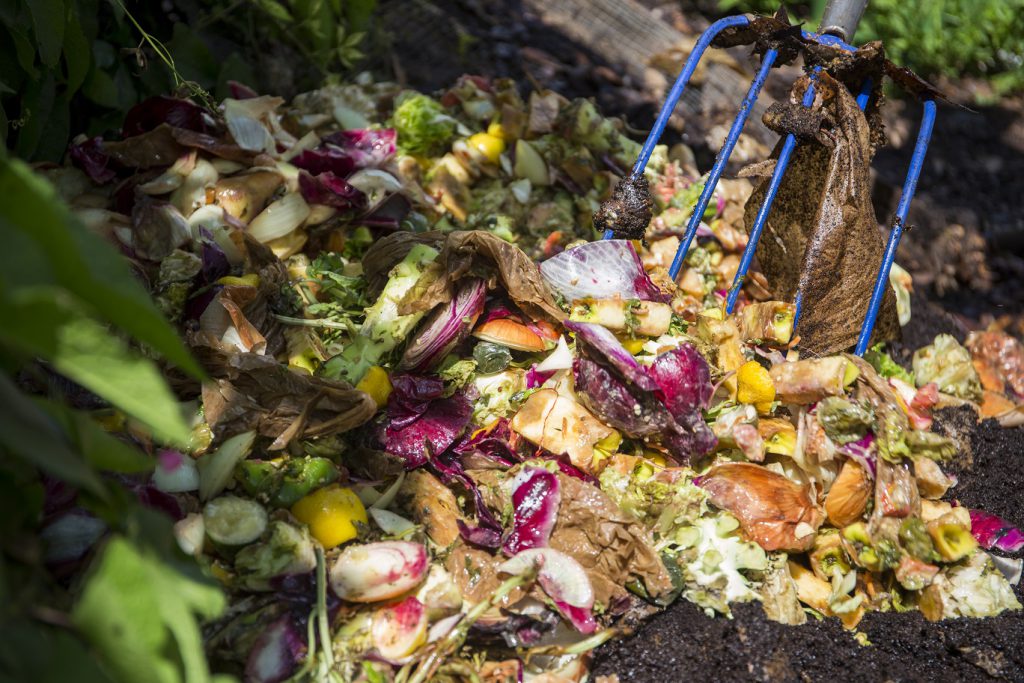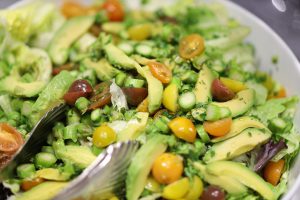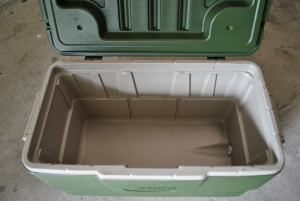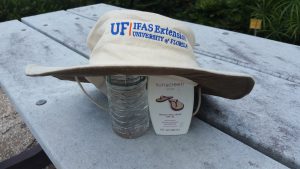
by Samantha Kennedy | Mar 17, 2021
Food waste is a huge problem here in the United States. Here are a few incredible facts: Food is the most common solid source of waste in American landfills. Anywhere from 25-40% of food grown, processed, and transported in the US will never be eaten. Food waste harms the environment and results in a lot of wasted money.
Looking for ways to reduce food waste? Just follow these six tips.
Plan meals carefully. Only purchase what will be eaten in a reasonable amount of time, especially perishable items. Buying large quantities of fresh produce, dairy, and other perishables may seem like a time-saving practice. However, throwing spoiled food away not only wastes money, but also time, since the spoiled items need to be replaced during another trip to the market.

Instead of throwing old fruits and vegetables away, turn them into nutrient-rich compost to help your garden thrive. (Photo source: Camila Guillen, UF/IFAS)
Freeze or re-use food whenever possible. Not all food freezes well. However, fresh fruits and vegetables freeze quickly and easily when handled properly and can last in the freezer for months. Vegetable scraps are also great for making compost, which enriches the soil and can help support the growth of backyard gardens.
Look at the sell by/use by/best by dates on food products. Try to purchase items with the longest shelf-life (the latest date) available. If a product is close to its sell by date, be sure to use it or freeze it quickly. Keep in mind, however, that just because a product is past its use by date does not mean it is unsafe to eat. Take it on a case-by-case basis. If there is no mold, pests, off odors, off colors, or off textures, the product is safe to consume. This is especially true for dry, non-perishable items.
Store food properly. Storing foods at the wrong temperatures can speed up the spoilage process. Keep the refrigerator between 37 and 39 degrees Fahrenheit. Dry goods storage should ideally be around 50 degrees F, but since this is not realistic for most of us, just make sure dry goods are stored in a cool, dry place outside of direct sunlight.
Stay organized. Arrange items so that the oldest stuff is in front. This helps ensure it is used first. Always label frozen foods with the item name and date it was first frozen and use within 12 months whenever possible. Foods frozen for longer than a year start to diminish in flavor and texture. Old food also tends to attract pests, so making sure things are used efficiently can help eliminate the risk of insects and rodents.
Donate non-perishables to those in need. Food banks and other community organizations are always looking for food donations to help the hungry. Non-perishable foods that have not surpassed their use by/sell by dates are always welcome donations. Instead of trashing it, share it with someone less fortunate.
In most cases, food affected by flood damage or other disasters should be discarded for safety reasons. Better to be safe than sorry. However, everyday food waste is completely avoidable if a few simple rules are followed. The amount of food thrown away each year in the US is disheartening. When shopping, being a little more mindful of quantities and dates can help reduce overall food waste, saving both money and the environment.
Additional Resources:
National Center for Home Food Preservation (University of Georgia Extension)
Food Waste Resources (Kansas State University Extension)
UF/IFAS is an Equal Opportunity Institution.

by Samantha Kennedy | Jan 14, 2021
Guess what, guys? We made it! We have finally put 2020 behind us and are now looking forward to 2021. I, for one, am hopeful. I am expecting great things from this year.
Admittedly, I have not always had an optimistic outlook. I used to like to say that I was a natural-born cynic. And while I still have cynical tendencies, I have learned strategies over this last challenging year that have really helped me look at things more positively and helped me deal with stress.
It all starts with mindfulness. While this has really become a bit of a buzzword in recent times, the foundations of mindfulness are solid and based on research. At its most basic, mindfulness refers to the practice of being in the moment. Sounds simple, right? Well, if your mental habits are as ingrained as mine were, it takes a lot of practice to be in the moment.
I am an overthinker. A brooder. A ruminator. As far back as I can remember, I have thought about things before I did them, then thought about them again for a long time afterwards. Especially if it was something I felt I had not done right or that did not go well. I would be driving or trying to sleep and thoughts, regrets, and recriminations would just be spinning, spinning, spinning endlessly in my head.

Spending time in a peaceful place without outside distractions is a great way to refresh and recharge. (Photo source: Marisol Amador, UF/IFAS)
This was just who I was. I had learned to live with it. I always knew that if something important was coming up, like an exam or a presentation, I would obsess about it beforehand to the point where I would lose sleep. If something happened that did not go well, I would fixate on it for days afterward.
It was stressful, but I dealt with it. And then 2020 happened.
Suddenly, I could not deal with it anymore. My obsessive ruminations and self-recriminations were suddenly unmanageable in the midst of the social isolation and worries brought on by the strains of a global pandemic.
I needed to find a way to change my outlook. A way to deal effectively with the overwhelming feelings I was experiencing. I wanted to be more positive. I wanted to stop seeing doom over every horizon. Most of all, I wanted to stop obsessing about everything all the time.
So I started reading about mindfulness. Then I started trying to practice it. I say “trying” because there are still days where I am just not feeling it, where I am just not able to find that quiet space inside myself that I need to tap into to be in the moment. However, I have gotten better at it with practice.
The key is breathing. Focusing on my breath – each inhale and each exhale, one after the other – allows me to feel centered, to relegate my other thoughts to the background. When outside thoughts arise, I have learned how to push them away and concentrate on the moment. And the next one. And so on.
The best part about this practice is how portable it is. No matter where I am, I always have my breath. If I am feeling overwhelmed or angry or sad or frustrated, I can simply take a few moments to concentrate on my breathing, allowing those feelings to just be, and, eventually, they pass, leaving me feeling refreshed.
I encourage all of you to take on 2021 with a mind towards mindfulness. You may be surprised at just how much a few minutes of purposeful breathing each day can improve your overall outlook. It has really changed my life.
For more information about mindfulness, check out the UF/IFAS Extension fact sheet Mindfulness: An Introduction.
UF/IFAS is an Equal Opportunity Institution.

by Samantha Kennedy | Nov 10, 2020
It has often felt like time has dragged on in 2020, but despite all the challenges, time has continued to march on, and that means the holiday season is right around the corner. Thanksgiving is fast approaching; November 26th will be here before we know it. And while this year has been tough in many ways, we also have a lot for which to be thankful.
One of the ways we celebrate that gratitude is through a nice meal with friends and family. However, many of us have experienced financial difficulties over the last several months, which may put a damper on our traditional celebrations.
With that in mind, here are a few tips for saving money this Thanksgiving:

Keeping the sides simple and having guests contribute items to the meal are two ways to reduce the overall cost of a Thanksgiving meal. (Photo source: Tyler Jones, UF/IFAS)
Shop with a list. This is good advice for everyday shopping, too, but especially at the holidays, when there are just so many delicious seasonal goodies available and we might feel like splurging. Don’t get carried away, though! Stick to traditional favorites everyone enjoys and only get enough to feed the number of guests, not an army. And remember, if it’s not on the list, don’t buy it.
Shop early. Supermarkets often begin putting holiday food items on sale weeks before the main event. Planning ahead and purchasing ingredients early can save money in the long run. Also, think about purchasing canned and dry goods for next year’s festivities right after this Thanksgiving, as ingredient prices are reduced in order to sell them more quickly and make room for other items. Just remember to check the expiration/sell-by dates to make sure they do not expire before next year.
Choose one type of meat. Turkey is the traditional centerpiece to most American Thanksgiving meals, but it doesn’t have to be. Other popular meats include ham, lamb, roast, and prime rib. The key to saving money on the meat, however, is to choose just one. Meat is one of the most expensive items on a Thanksgiving menu, and, odds are, if there is an abundance of side dishes, there won’t be a need for as much meat.
Frozen over fresh. As for the turkey, go with a frozen store brand turkey. The savings could be significant over a name brand or fresh turkey. Just remember, frozen turkeys take time to thaw safely in the refrigerator. Plan for 24 hours of thawing time per five pounds of turkey. For example, a 15-pound turkey will take at least three days to thaw in the refrigerator. Remember to place the turkey in a pan to prevent juices from dripping onto other food in the refrigerator.
Make it a potluck. Ask guests to bring a dish to share with everyone else. This way, the expense is spread out over several people and everyone saves money. There are some really great free websites that allow people to sign up to bring certain items. Customizing the sign-up helps ensure that everything is accounted for and that there isn’t a pile of pumpkin pies but no side dishes.
For more information about holiday savings tips, contact Samantha Kennedy, Family and Consumer Sciences agent, at (850) 926-3931, or reach out to your local Extension office.
Additional Resources:
Five Steps to Seasonal Savings (UF/IFAS Extension)
Food Safety Tips for the Holiday Season (UF/IFAS Extension)
UF/IFAS is an Equal Opportunity Institution.

by Samantha Kennedy | Aug 19, 2020
A friend of mine recently shared with me a few recipes for what is known as “cooler corn.” As the name implies, it’s a way of cooking a large amount of corn on the cob all at once inside a cooler, thereby saving time and grill and/or stove space.
At first I was intrigued. I had never heard of this cooking method before and my own personal curiosity was piqued. However, as a certified food safety instructor, I was also immediately horrified. As I reviewed several recipes for this “perfect way to make corn for a crowd,” I became increasingly alarmed. There were so many proper food safety practices violated, it nearly turned my stomach.
Cooking food in a cooler is an unsafe cooking method. Coolers are not designed to withstand the high temperatures required for cooking and cannot adequately hold foods at safe temperatures for prolonged periods of time.
For the record: Cooking corn in a cooler is UNSAFE. The safest ways to cook corn are in a stockpot on the stove, in the oven, or on a grill.
Here are the top four reasons this cooking method is not a good food safety practice:

Cooking food in a cooler is an unsafe cooking method. Coolers are not designed to withstand the high temperatures required for cooking and cannot adequately hold foods at safe temperatures for prolonged periods of time. (Photo source: Samantha Kennedy, UF/IFAS Extension)
1. Coolers are not designed to be used for cooking. The plastic used in coolers is not meant to withstand continued exposure to boiling water and will start to degrade over time. The plastic can also be easily scratched or gouged, providing the perfect place for foodborne pathogens such as Salmonella and E.coli to hide and grow. Think of the other things coolers are used for: storing fish or game after fishing or hunting, keeping drinks cold, storing raw meat or poultry for a picnic, etc. There are so many other opportunities to contaminate the cooler before it is used for cooking corn, even thorough cleaning and sanitation may not be enough to eliminate pathogens. Always keep cooking utensils and tools CLEAN to reduce your risk of foodborne illness.
But what about the boiling water? Won’t that kill any pathogens? Well, yes and no. See #4 below.
And NO, having a cooler dedicated only to cooking corn will not solve all the problems stated above. The bottom line is COOLERS ARE NOT SAFE TO COOK FOOD IN.
2. One of the conveniences of this method, as celebrated in the various recipes, is that people can just reach into the cooler and grab a perfectly cooked ear or two whenever the mood strikes. Allowing people to reach in and grab food like this – especially with their bare hands – is a very unsafe practice. People may forget to wash their hands properly before reaching in, thereby adding dirt and bacteria to the water and thus the food. This type of “germ-sharing” is called cross-contamination and is one of the leading causes of foodborne illness. Always keep things SEPARATE. This includes keeping raw food separate from cooked food, using separate utensils for each food, and reducing or eliminating bare hand contact with food.
3. Stacking dozens of ears of corn in a container and submerging them in boiling water does not ensure that all of the corn will be cooked evenly. The ones in the middle may not be cooked all the way through and there may also be temperature fluctuations in different areas of the cooler because of the way the food is stacked. There may be hot, warm, and cool spots, which can lower the overall temperature to an unsafe level and promote the growth of pathogens. Always COOK foods to the proper minimum internal temperature. In the case of corn, this is 135 degrees F. This can be measured by inserting a properly calibrated food thermometer between two cooked ears of corn and waiting until the needle stops moving.
4. One blog post about the wonders of Cooler Corn stated, “You can leave the corn in there for quite a while after it’s done cooking to keep the ears warm. Since the temperature naturally drops over time, the corn doesn’t get mushy.” When I read this, my mind screamed, “DANGER!” in flashing red letters.
Boiling water is a good sanitizer. However, a lot of what makes it effective for killing pathogens has to do with proper contact time with surfaces AT THE APPROPRIATE TEMPERATURE. Most coolers are not designed to keep boiling water that hot (212 degrees F) for any significant period of time. Even quality coolers will not hold the temperature long enough to ensure proper sanitation and elimination of pathogens.
One of the most important food safety principles is keeping cold foods cold and hot foods hot. To ensure the safety of food, it is important to keep cold foods below 41 degrees F and hot foods above 135 degrees F.
Now think about ears of corn submerged in water for a prolonged period of time, as the water slowly cools. After a while, that water will no longer be able to keep those ears of corn above 135 degrees F. They will basically be sitting in a soup of tepid water at the most favorable temperature for pathogens to grow. The longer the corn sits in that water, the higher the risk of foodborne illness. Always properly CHILL foods to keep them at a safe temperature, below 41 degrees F. The flip side of this coin is to also ensure hot food stays hot, above 135 degrees F.
Cooking for large groups can be a challenge, especially when kitchen space is limited. (Check out the UF/IFAS Extension fact sheet “Food Safety at Tailgating” for more food safety tips when cooking out.) However, it is never a good idea to sacrifice food safety for convenience. Always follow proper food safety practices, no matter the situation, and remember the 4 principles of safe food: CLEAN. SEPARATE. COOK. CHILL.
UF/IFAS in an Equal Opportunity Institution.

by Samantha Kennedy | Jul 16, 2020
An abundance of sunshine is one of the many reasons why so many people love Florida. In fact, it is why we are known as “The Sunshine State.” However, while the sunny days provide tons of opportunities to enjoy the great outdoors, too much sun exposure can lead to minor injury, serious illness, or even death.
The harsh UV rays from the sun can begin to damage the skin in as little as 15 minutes. In fact, even if the skin is not outwardly burned, it may be damaged underneath. Continued unprotected short-term exposure adds up over time, leading to more serious skin damage such as melanoma.

Sunscreen, ample water, and a good hat are all excellent precautions against problems with the summer sun. (Photo source: Samantha Kennedy)
Adopting a few sun safety practices greatly reduces the risk of serious skin damage. One simple practice is the daily application of sunscreen, even on cloudy days, as UV rays can penetrate cloud cover. A minimum Sun Protection Factor (SPF) of 15 is recommended for exposed skin, including lips. Do not use sunscreen past its expiration date, as it may not be as effective.
Eyes should be protected as well, as prolonged exposure to the sun can lead to vision loss or even blindness. Sunglasses which protect against both UVA and UVB rays offer the best protection. Wraparound sunglasses offer the most comprehensive protection of both the eyes and the tender skin surrounding them.
Cover other exposed skin as much as possible with dry, loose-fitting clothing whenever possible, on top of wearing sunscreen. Reapply sunscreen every two hours, especially during continuous sun exposure and after swimming, sweating, and toweling off.
Children under one year of age should be kept out of the sun as much as possible. Keep babies in the shade of a tree, umbrella, or stroller canopy at all times. Older children should follow the same precautions as those given above. Keep in mind, very young children cannot state it is too bright or too hot, so be extra vigilant.
Staying cool and hydrated is also important during those hot summer days. Even those who are acclimated to the climate can easily fall into the dangerous trap of dehydration and overheating. Paying attention to the body’s needs will help prevent heat stress and more serious heat-related illness.
The sun is at its hottest and most brutal between the hours of 10 a.m. and 4 p.m. Reducing outdoor activities between these hours can help reduce the risk of overheating. If this is impossible, be sure to take frequent breaks in a cool, shady spot to help maintain proper body temperature.
Lightweight, light-colored clothing reflects heat better than heavier, darker colors. Hats with wide brims going all the way around are ideal and offer more protection to the ears, neck, and scalp. Baseball caps are fine, but be sure to use a cloth in the back that drapes over exposed skin for more protection.
Drink plenty of fluids constantly. Plain water is the best choice to maintain proper hydration. Avoid alcohol, caffeine, and high amounts of sugar, as these can promote water loss, leading to dehydration. Find a shady spot or an air conditioned space to retreat to periodically throughout the day to keep from overheating.
Some symptoms of heat exhaustion include excessive sweating, confusion, dizziness, weakness, and nausea. Seek shade or air conditioning immediately.
Anyone experiencing an elevated body temperature, hot and dry skin, continued nausea or vomiting, and/or loss of consciousness may be suffering from heat stroke or other severe heat-related illness. Seek medical attention right away.
Florida’s sunshine draws millions of visitors a year. But for visitors and residents alike, it can be dangerous without the proper precautions. By being sun smart, the dog days of Florida’s summer will not take a bite out of the fun.
Resources:
Be Safe in the Sun (American Cancer Society)
Sun Safety (Centers for Disease Control and Prevention)
UF/IFAS is an Equal Opportunity Institution.










